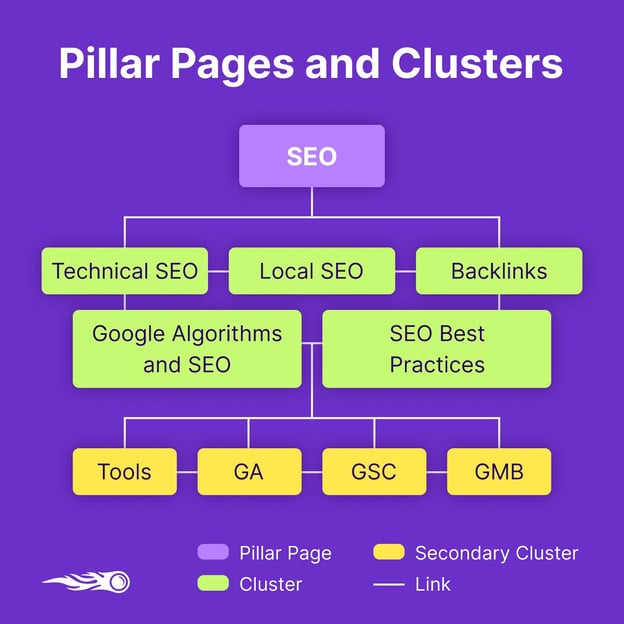
When you learn the basics of SEO, you realize one of the main drivers is content. This should follow a logical progression - so if we want to learn about an
overarching topic such as SEO, for example, it would make sense to break it down into its component parts and learn about each subtopic individually to get a deeper understanding of the subject as a whole.
Topic clusters are a way of organizing your content that mirrors the way we acquire knowledge and can make a big difference to your SEO.
1 What Are Topic Clusters?
Topic clusters, or content clusters, as they’re also known, break content down into two categories:
- Core topics / Pillar Pages - Such as "What is SEO?"
- Subtopics / Subpages - Such as "Backlinks, Algorithms and Best Practices"

Image from: https://www.semrush.com/blog/topic-clusters/
Your pillar posts should provide a broad, but complete overview of the core topic. They then link to your subpages to explain specific concepts in greater detail. This creates a clear structure, where all the subpages link back to the overarching pillar post, signaling the importance of the page, and helping readers to easily explore the topic.
2. The Benefits of Topic Clusters
The major benefit of topic clusters is a logical flow to your content creation. They allow readers to answer new questions as they arise.
For example, you might start with the basic question of “what is SEO,” but as you’re reading through, you suddenly want to know more about SERPs. With topic clusters, you can easily facilitate people’s curiosity and answer their questions in as much detail as they need.
When you’re doing a great job of satisfying your visitors, SEO results tend to come, and that’s also true with topic clusters. This is because Google and the search engines use internal links to understand your website. Good internal linking helps give meaning to pages and show how they interrelate, and topic clusters ensure you’re linking pages in a logical, helpful way.
Lastly, the planning that goes into topic clusters is an excellent way of organizing your thoughts. As you’re creating your pillar posts, subtopic ideas should come to you naturally, helping you create a consistent content calendar.
3. Five Steps for Creating Topic Clusters
Topic clusters aren’t complicated - they just take a bit of planning. Users want your website to have a logical flow, but if you’re not taking the time to plan your content, then this is difficult to achieve.
A. Decide On Your Core Topics
What are the big questions your users have? For us as a digital marketing agency, this often breaks down into SEO, PPC, social media, email marketing, etc.
These ideas are generally linked to the products and services you sell.
Understanding these core topics is simply a question of brainstorming. Make use of free tools like answerthepublic for ideas to draft a rough structure and understand how the ideas link together.
Looking at your sales funnel can also be a big help as you’ll often find that the questions that get asked at the beginning of the customer journey are usually quite general such as "What is PPC?".
B. Do Your Keyword Research
When it comes to the pillar posts, you should have a pretty good idea of what’s most important to your users. However, the deeper you go with the subtopics, the more you will need to be guided by data.
You’ll often find that people don’t search quite as you might expect, which is why keyword research is so important.
Again, an SEO tool - click here are some of our favorites - like answerthepublic can help you explore the ways your target audience searches and make sure all your content is focused. This is also a great way to get new topic ideas and build out your content calendar.
C. Create an Outline of Your Structure
Once you’ve written out a good list of topics, then you can start to draft an outline for your structure. This visualization is important because it lays out how the ideas link together and showcases the hierarchy of the pages.

At the heart of topic clusters are internal links, so your outline helps keep you on track and makes sure you’re maximizing your SEO. You might decide to add in secondary clusters that go even deeper than your subtopics (e.g. SEO > SERPs > Featured Snippets).
The key thing is ensuring that these related ideas are linked together for your users and the search engines to make the connection and easily explore content in greater detail.
D. Create Your Content
You’ll find that once you’ve got a focused content calendar and a clear picture of how ideas link together, your content creation will be much easier. For the pillar posts, you’ve already got a rough outline of everything you need to discuss, including the subtopics, and an easy-to-follow linking strategy.
Now it’s just about guiding people through your topic clusters with valuable, engaging content. Try to focus on a logical flow of ideas, providing a broad overview with the pillar posts, and saving the minute detail for the subpages.
Use your keyword research to see what the top organic results (and your competitors) are doing well, and find ways you can improve on what they offer. The SERPs give you lots of clues as to what users are looking for, so critically analyze the top results and see where you can create an advantage.
E. Keep Optimizing What You’re Doing
SEO isn’t about putting up a blog and forgetting about it. The SERPs are always changing, so you need to make sure you’re tracking your performance and continuing to build on your hard work.
This will involve looking to build backlinks to your content, updating and editing existing content accordingly, and continuing to create new and relevant content.
Not every piece of content you create is going to get straight to the top of the rankings the first time around. You’ve invested a lot of resources in each article though, so it’s worth continuing to optimize it to get maximum exposure.
Keep tracking your analytics to understand how people are interacting with individual pages, and how they navigate your site. This can help you find gaps in your content and make improvements to offer a better user journey for your audience.
Conclusion: Topic Clusters can Deliver Results
Topic clusters are a natural, logical way of organizing content. They reflect the way people learn, thus mirroring the way they explore your website, and subsequently, how Google organizes information.
This ticks two very important boxes in SEO: Understanding and engagement.
The search engines have to be able to understand what your website and the individual pages are about. One of the ways they do this is by following all the internal links to see how ideas fit together.
Your users engage with your website in a similar way. They follow links to learn more, but it’s not possible to do this if your content isn’t laid out in a logical way.
Topic clusters address this issue by adding structure to your content, making it easy for humans and bots to navigate your site and build a comprehensive understanding of what the pages are about.
We hope this article was helpful, but sometimes, the planning and implementation of Content Clusters can be overwhelming. That's why it's probably a good idea to call KeyScouts and see if you qualify for a free Content Cluster Consultation!





